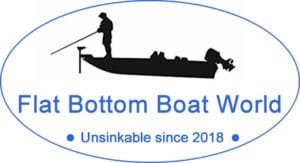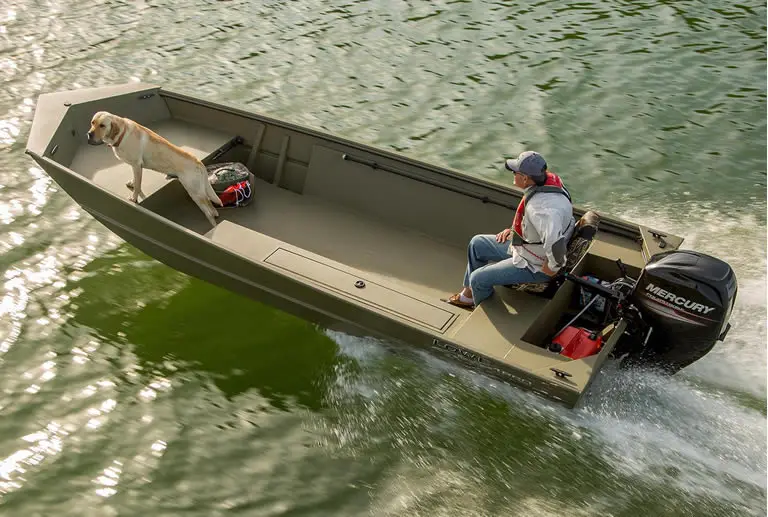Contents
- What Is A Jon Boat?
- Advantages Of A Jon Boat
- The amazing benefits of the flat bottom hull
- A Jon boat is a shallow water warrior
- The Jon is the ultimate small utility boat
- A Jon boat can be a great platform for water-based hunting
- A Jon boat is fantastic for freshwater fishing in shallow waters
- Planing a Jon boat for a smooth fast ride is easy
- Lastly, Jon boat offer exceptional value for money
- Disadvantages Of A Jon Boat
- Jon Boat Propulsion Types: Pros And Cons
- Comparison With 2 Similar Boats
What Is A Jon Boat?
A Jon boat is a lightweight, flat-bottomed utility vessel usually used on inland waters.
A Jon boat has a shallow draft and low freeboard so it can be used in very shallow waters.
It can be manually powered by paddle or oars and can be fitted with an outboard trolling motor.

Its unique hull design means a Jon boat is an excellent fishing, hunting, recreational and utility vessel for calm, shallow inland waters such as rivers, ponds, creeks and lakes.
Jon boats range from the very basic to the more substantial in regards to size, construction material and level of equipment they utilize.
The most significant feature of a Jon boat is its flat-bottomed hull, a design that gives it a shallow draft allowing it to be used in very shallow water.
A Jon boat can be used to access areas where the water is only a few inches deep.
The Jon boat’s flat bottom hull also has the added advantage of offering great stability in calm waters such as lakes and inland waterways, at both speed and at standstill.
The main uses of a Jon boat
A Jon boat is a popular watercraft used for fishing, hunting, transportation, utility work and recreational activities.
As it has a flat bottom and shallow draft it is almost always used on inland waters.
For some, a boat is a necessary piece of equipment required to enable the user to carry out specific tasks, like transporting goods and passengers for example
For others a Jon boat is the best option to assist them in recreational pastimes such as fishing and hunting etc.
Either way, a Jon boat can be the ideal boat of choice for a variety of reasons.
But what exactly is a Jon boat and why has it become so popular with fishing enthusiasts, hunters and people who use the waterways for transporting goods?
A Jon boat is popular as an introductory boat for the beginner to acquire some elementary boating skills especially in narrow and/or shallow waters.
It is also the preferred craft for a number of sporting and hunting activities, recreational uses and transportation needs.
In short, a Jon boat is a basic, no frills utility boat.
It is popular because of its renowned versatility, low purchase and maintenance costs, its tough construction and its unique ability to traverse narrow shallow waterways.
It is also loved for its superior stability on calm water.
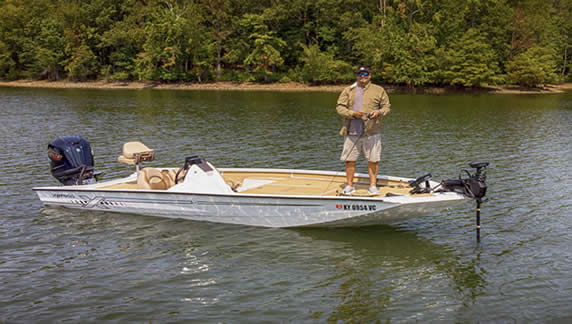
A Jon boat is a very adaptable, shallow draft boat that is extremely versatile with a vast range of uses.
They are typically small, inexpensive and lightweight boats usually manned by one or two people and are more often than not the perfect choice for leisure use especially in shallow waters.
Jon boats can be easily adapted for fishermen or water borne hunters, with the aid of some accessories, and for general transportation.
A Jon boat is usually constructed from wood, fiberglass, or more commonly from aluminum, and in most instances is built with a bench for the occupants to sit on.
These bench type seats double up as stiffeners to support the open hull.
Jon boats are produced by various manufacturers and are available in different sizes with various levels of finish and features.
Due to their simple construction however, DIY efforts can also produce equally sound vessels and many owners will also perform upgrades on their store-bought boats themselves.
The lightweight construction of a Jon boat, depending on material used, means a boat can weigh between 100 – 300 lbs.
This means it is easy for the smaller, lighter Jon boats to be manually lifted onto a vehicle’s roof rack by two people.
The larger and better equipped Jon boats (those closer to the 300 lb mark) can still be effortlessly moved on and off a trailer at the water’s edge single handed.
Not only are they easy to launch but because the boat and trailer’s combined weight is low, a Jon boat can be towed using a regular car.
For example, an unmodified 15-foot Jon boat weighs about 210lbs, a small boat trailer weighs around 150lbs – 200lbs and an outboard motor, with fuel and general accessories will weigh roughly another 150 lbs.
This is a total weight of around 560lbs which is well within most cars towing ability.
Various sizes of Jon boat are available that range in length from 8 – 20 feet although the mid-range boats are usually 10 – 15 feet in length.
The boat length will determine the type of waterway the boat is used in while the width or ‘beam’ of a Jon boat ranges from around 48 – 75 inches.
It should be noted that the wider the vessel, the more stable it is.
You can learn how to make a Jon boat more stable here.
Many owners will widen their boats themselves as a DIY project to increase the stability of the boat.
If you want a more detailed outline of what Jon boats are used for read this article.
Advantages Of A Jon Boat
A Jon boat has the following advantages:
- The flat bottom hull gives a Jon boat a district advantage over many other craft.
- A Jon boat is an excellent for shallow water conditions.
- Jon boats are the ultimate small shallow water utility vessel.
- A Jon boat is perfect for recreational day boating, fishing and hunting.
- Jon boats are lightweight and easy to handle in or out of the water.
- The design of a Jon boat means it’s easy to get on plane – thus offering high speed in comfort.
- These utility vessels are inexpensive with little running or maintenance costs.
- A Jon boat can be easily enhanced or customized to suit your exacting needs.
- The sturdy, robust construction ensures the longevity of a Jon boat (and offer great value for money).
Why the Jon boat is so popular
So why has the Jon boat’s popularity on rivers, creeks, ponds and lakes remained constant, if not actually increased, in America?
The amazing benefits of the flat bottom hull
Synonymous with Jon boats and their simple design is the flat hull which has become the boats recognizable feature.
The result of the flat-bottomed design enables Jon boats to easily access and traverse bodies of water where the depth is only a few inches deep.
This hull design has a relatively large beam (width of the hull at the waterline), which offers the boat great stability in calm waters.
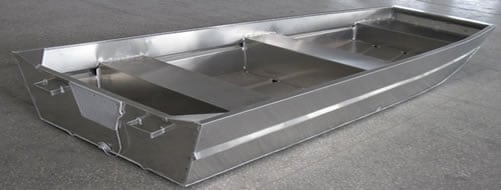
The downside is that the flat bottom design doesn’t fare so well in choppy waters or in the open sea where it would be susceptible to capsizing in such conditions.
Given that the hull is flat, this means that the floor area within the boat is also flat.
A flat floor creates an unobstructed area for the crew to move around or for the storage of goods and equipment.
A Jon boat is a shallow water warrior
Anglers love to talk about ‘skinny water’ or the shallows which seem to add another dimension to their fishing experience.
Hunters too often find themselves chasing prey into shallow waters. It is in these situations where a Jon boat comes into its own
Having such a shallow draft, as a result of its flat-bottomed hull, the Jon boat is at home in mere inches of water depth.
For example, at the water’s edge, the shore can obscure hidden dangers to water craft on the river or lake floor such as boulders, hidden tree stumps and sand banks etc. all of which are treacherous ground for ‘V’ style hulls.
So, a flat bottom Jon boat is the perfect choice for traversing these types of potentially hazardous environments.
However, even if a Jon boat were to encounter such rough underwater terrain they are hardy enough to cope with most bumps and scrapes given their sturdy construction.
The Jon is the ultimate small utility boat
Of course, fishermen and hunters are not the only ones who will use a Jon boat. These all-round boats are renowned for their versatility.
They are also very customizable and as such they can become a formidable and serious contender to do the kind of water-based jobs larger vessels simply can’t.
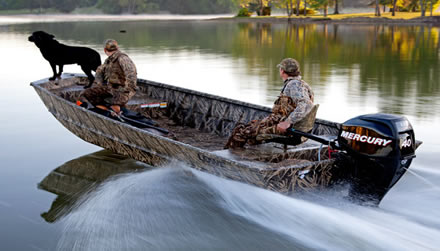
With their unmatched durability, incredible lightness and rock-solid strength, the Jon boat has been used not only for fishing and hunting but for recreational holiday makers, water sports and even Jon boat racing.
They are known as “the workhorse of the waters”, often being used for the transportation of goods and for ferrying passengers across waterways.
Because they can be modified in an infinite number of ways, the Jon boat is arguably the ultimate American small utility boat.
A Jon boat can be a great platform for water-based hunting
Hunter types are cut from the same cloth as fishermen, they’re either talking about the sport or they’re in among the reeds, jostling the overhanging tree branches and going all commando in the shallow waters just to try to gain that extra inch to get closer to their prey.
Once again, a Jon boat can prove to be indispensable.
To a water-based hunter a Jon boat offers many advantages over other boat types for all the reasons listed above.
So, it goes without saying that the boat of choice used to accommodate these wilderness warriors is their beloved Jon boat.
A Jon boat is the perfect water-based platform to provide exactly what the intrepid hunter needs.
Prey that hide among the shoreline habitat or swamp root systems are accessible via a Jon boat because it offers stealth, silence and agility when required.
It’s clearly an advantage to a hunter to get as close to their prey as possible and a Jon boat offers that advantage.
Hunting can require a lot of gear and additional four-legged passengers. So be sure to know the weight capacity of your boat, as outlined here.
A Jon boat is fantastic for freshwater fishing in shallow waters
Because a Jon boat is a perfect tool for engaging in one of the world’s leading sport and pastimes i.e. fishing, it is often said that it was a fisherman who invented the Jon boat (though many would argue the point).
There is probably no two fishing Jon boats built the same way, given the vast array of accessories that fishermen use to customize their craft.
When a Jon boat is converted to a personal fishing boat it is built to accommodate the requirements of the individual and one that suits a specific fishing style.
Whether it’s shallow water bass fishing or angling in open waters, a Jon boat is without doubt, the real fishermen’s friend.
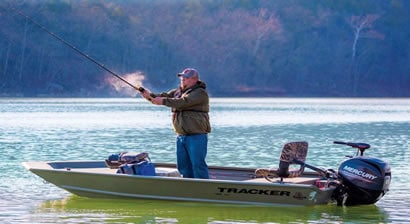
Jon boats are relatively inexpensive, robust and perfect for fishing in shallow waters.
For some basic instruction on how to handle a Jon boat and to learn a little more about boating in general, why not join a local boat club where they have the facilities to offer some tuition and boat hire.
It’s a great way to make a start in the boating world and gets you among like-minded fishermen and boating enthusiasts.
Planing a Jon boat for a smooth fast ride is easy
Flat bottom Jon boats are also the perfect choice for allowing a fairly small outboard motor to accelerate the boat to the point where it is planing.
Planing occurs when the bow of the boat initially rises out of the water when engine power is applied before settling down. Then the rear of the flat hull rides on the surface of the water (like the Jon boat in the featured image below).
The term planing could also be described as one where a vessel’s weight is supported by hydrodynamic forces, rather than by buoyancy.
It is said that a flat-bottomed hull, while planing, is more fuel efficient than V shaped or displacement type hulls travelling at the same speed.
The planing speed for Jon boats varies from boat to boat according to several factors such as:
- The the size of the boat
- The size of the motor propelling it
- The boat’s laden weight.
In calm waters a Jon boat offers an exceptionally smooth ride even at speed.
In choppy waters too much speed however, and the safety of the crew and the boat are brought into question.
If there are choppy waves the boat will skip across the water’s surface at very high speeds.
This will not only make for a less comfortable ride but will also increase potential safety concerns.
The hull will slap against the water which may stress it to the point of failure or cause the boat to start taking on water.
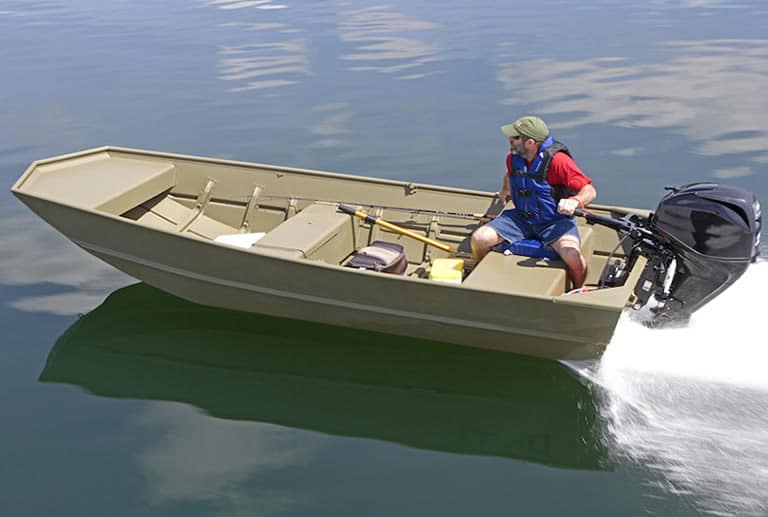
So it’s important that an apt engine size to boat size ratio is observed.
So, an apt engine size to boat size ratio is strongly advised.
Note: A boat should display a capacity plate (a plate that displays the maximum horsepower rating) for the boat. The motor you use should never exceed this rating.
Jon boats can be easily customized
The simple design of the Jon boat lends itself to easy modification.
In fact, it is so easy to customize this boat that many boaters can convert a jon boat to a bass boat with relative ease.
Lastly, Jon boat offer exceptional value for money
Jon boats are fairly cheap (see our Jon boat cost guide) to buy and maintain.
But, the fact that they are very long-lasting just adds to their value for money.
Disadvantages Of A Jon Boat
With pros come cons. Nothing is perfect and the Jon boat is no exception. Below are some of the disadvantages a Jon boat offers the user.
- Uncomfortable and cramped when used over long periods of time
- Limited amount of space for onboard storage
- Motorization can only come from a rolling motor.
- Unstable in rough water and open sea
- Speed limitations
Jon boats popularity is down to its simple design that allows it to be a ‘jack of all trades’. So it’s easy to see why they’re commonly used by individuals and groups for an array of different watery adventures.
Discomfort comes as standard
Jon boats lack any mod cons and are a far cry from the type of flat bottom luxury vessels that you sometimes see in similar inland waters.
Where a pontoon boat has the same type of shallow draft as a Jon boat, a Jon has none of the trappings of comfort that the pontoon boat has.
Jons are simple utility vessels, built for purpose rather than comfort.
Jon boats offer only limited deck space
Low prices and a focus on basic utility needs means something has to suffer. In the case of the Jon boat it’s space.
Where larger flat bottom skiffs will have plenty of deck space and enough room for plenty of fishing and hunting gear, you will need to be more reserved in your gear choices on a Jon boat – especially if you have passengers.
Motorization is limited
Sure you can get a good bit of speed out of a Jon boat when you get the boat on plane but as far as motor power goes, you are limited.
Only weaker trolling motors can be mounted on Jon boats as higher-powered outboard motors would overwhelm these little vessels.
Where a skiff or bigger boat can be fitted with a powerful outboard motor, that is controlled via a center console and steering wheel, a Jon boat will be propelled and steered by a tiller controlled trolling motor.
Of course there are mods you can add to give you central control over the motor most Jon boat owners are stuck at the stern with a hand on teh tiller.
Jon boats are not designed for rough water
No matter what you read online – Jon boats are not safe in rough water! And, only under very strict conditions can they be used in the ocean.
Now, that is not to say that you cannot take your Jon boat out into saltwater lakes.
You can, as long as you give the boat proper protection against galvanic corrosion – see our guide to using a Jon boat in salt water.
Speed is available but it’s limited
When you get on plant on a Jon boat you can increase the boat’s speed to the max of the motor.
The ride will be smooth. But, although it will feel fast, those speeds are nothing compared to skiffs and other boats powered by big outboard motors.
Why is a Jon boat called a Jon boat?
Why is a Jon boat called a Jon boat?
The name “Jon boat” has contentious roots as its true origin is unknown.
Some say the name was derived from the Scandinavian man’s name ‘Jon’, as this was a very common personal name among people who used this type of boat.
Another theory of the ‘Jon boat’ name states that it originated from the use of the Jack pine timber used in the construction of the boats and over time ‘Jack’ became ‘John’.
The problem with many current theories is that they don’t really seem very plausible – especially the one that involves Jack pine.
As Jack is a common name in English speaking communities it seems unlikely that the name Jack would be replaced by the name Jon, especially considering this is not a common spelling of the name (with “John” being favored by most people).
If the boat had been named after its construction material then it is much more likely it would have been called a “jack boat. So it is unlikely that name would have changed for the aforementioned reasons.
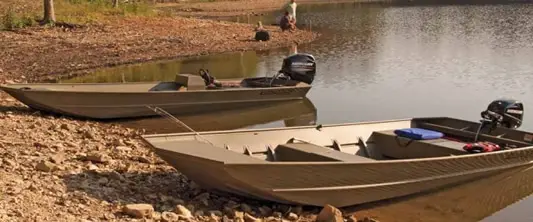
The more plausible of the most popular theories is the Scandinavian one.
Fishermen of this northern European region used Jon boats to haul gear and fish to their larger fishing vessels.
However, Jon is pronounced as ‘Yawn’ in the Scandinavian language, so many people think that the boat would have been called a “yawn boat” if this was its true origin of the name.
However it is not a stretch of the imagination to believe that English language speaking people would changed the name “yawn” to “Jon”.
A much less likely theory for the name Jon boat comes from suggestions that ‘Yawn’ was an old American slang word synonymous with describing just about anything that either didn’t have a name or that had a name that was too difficult to pronounce.
Thus, because the boat had no name it was called a “yawn boat” which eventually evolved into “Jon boat” over time.
Jon Boat Propulsion Types: Pros And Cons
For a Jon boat to be a successful utility craft it requires a versatile source of propulsion.
One propulsion type will better suit one activity while another may be preferred to a different type of activity.
Common types of propulsion used for Jon boats are:
- Outboard motors.
- Mud Motors.
- Trolling Motors.
- Non-mechanical types of propulsion such as oars, push poles and paddles.
Let’s look at these in more detail starting with the types of motor most commonly used on a Jon boat.
Motorized propulsion pros & cons
The most popular form of propulsion for a Jon boat is an outboard motor.
The type of motor used on a Jon boat is dependent on a variety of factors. These factors include, the size of the boat and expected pay load, the environment the boat is to be used in and the distances the boat is expected to cover etc.
Outboard motors are usually gas powered (although there are also propane and electric motors) and produce thrust through their propeller to propel the boat forward.
The amount of thrust required to sufficiently propel a boat will be dependent on the amount of energy the engine can impart on to the propeller.
An outboard engine’s output is measured in horse power (HP) units.
The larger the engine the greater the thrust.
Outboard motors are designed to attach to the transom and provide steering control through a pivot in the mounting mechanism.
Advantages of an outboard motor
- Good power to weight ratio
- Good for high speeds and cruising
- Detachable – good for servicing, winterizing and storage
- Clears deck space
Disadvantages of an outboard motor
- Expensive
- Require maintenance and servicing
- Noisy
- Running costs
Mud motor pros and cons
Mud motors are designed primarily for swamps and marsh type environments and for waterways and wetlands that would pose a threat to outboard motors.
Mud motors are similar to outboard motors in the fact they are gas motors mounted on the transom and they drive a propeller.
However, the drive to the propeller is much longer, the purpose of which is to set the propeller much closer to the surface of the water so it avoids potential hazards.
This design allows the prop to bounce off unseen underwater hazards such as tree stumps, rocks, heavy vegetation and logs etc.
So, mud motors can power a flat bottom boat in what, was once considered, the most hazardous of waterways.
Advantages of using a mud motor
- Good for swamp and marsh environments
- Very robust
- Simple design
- Low running costs
Disadvantages of using a mud motor
- Very noisy
- Slower than outboards
- No reverse gear
Trolling motor pros & cons
Trolling motors are generally electric, bow mounted outboard motors (although gas powered trolling motors are available for larger vessels).
These motors are typically used for maneuvering flat bottom boats in shallow water or when stealth is required when hunting (due to their silent running).
The motor is mounted within a sealed unit with a direct drive to the propeller and is regulated via tiller mounted controls or foot controls.
Trolling motors range from 12 volts to 36 volts and are powered by 12 volt marine batteries.
Advantages of using a trolling motor
- Good for silent running
- Relatively inexpensive
- Good for very shallow waters
- Foot controls keep both hands free
Disadvantages of using a trolling motor
- Slow speed
- Heavy batteries
- Limited use due to battery life
Manual Propulsion Pros & Cons
Other means to propel a Jon boat are of course oars, paddles and a push pole.
Equipment that is available to aid manual propulsion should always be kept onboard to offer an element of safety should a mechanical failure occur.
Keep in mind that having some form of manual propulsion such as oars, paddles or a dedicated ‘push pole’, like that found on a gondola can be very handy.
A pole is great for swamp use as sometimes it is necessary to move through very dense vegetation which could pose a problem to a motor.
Not only that but oars, paddles and push poles are also very useful for avoiding obstacles or for freeing the craft if it becomes marooned on sandbanks or rocks.
They are also useful if you find yourself in water that is just too shallow, even for a flat-bottomed Jon boat.
Comparison With 2 Similar Boats
Let’s take a quick look at the advantages and disadvantages of a Jon boat compared to two other popular shallow water vessels.
Advantages and disadvantages of Jon boat vs skiff
“Skiff” is an old term that was used to describe a small two-man row boat with a pointy bow, also called row boats or dinghies.
Several modern manufacturers have taken the name skiff and put it on all their boats as a brand and this has confused the market.
Most ‘skiffs’ are different sized fiberglass Jon boats.
Read our battle of the boats article Jon boat vs skiff.
Advantages and disadvantages of Jon boat vs bass boat
You will find a large amount of compelling evidence for both pro’s and con’s when comparing one boat to another.
The main question that seems to attract a lot of attention is, which is better between a Jon boat vs a Bass boat.
However, making a comparison between a Jon and a Bass boat is a bit like comparing a flatbed truck to a sports car.
Jon boats are simplistic boats that can become much more sophisticated when accessories are added to them or when they are customized for a very specific use.
A Bass boat on the other hand, is a dedicated boat built for bass fishing, or other panfish fishing. It is usually only kitted out with the equipment necessary for fishing.
Unlike a Jon boat which has multiple uses.
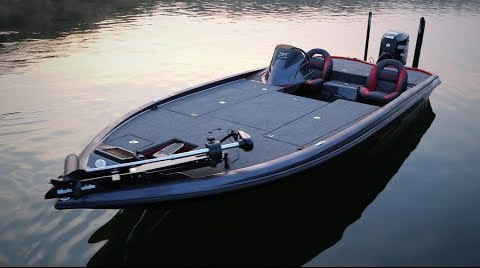
Bass boats also provide some comfort built-in for the fishermen such as swivel chairs, ample storage space and livewells (aerated water storage areas for live fish) as well as open, flat deck areas.
Jon boats can easily be converted into Bass-type boats though by adding a few necessary components specifically designed for fishing.
Purpose built Bass boats are more expensive than Jon boats which is the primary reason most people convert their Jon boat to a Bass boat.
The transformation costs are low and the upgrade is fairly easy to do.
